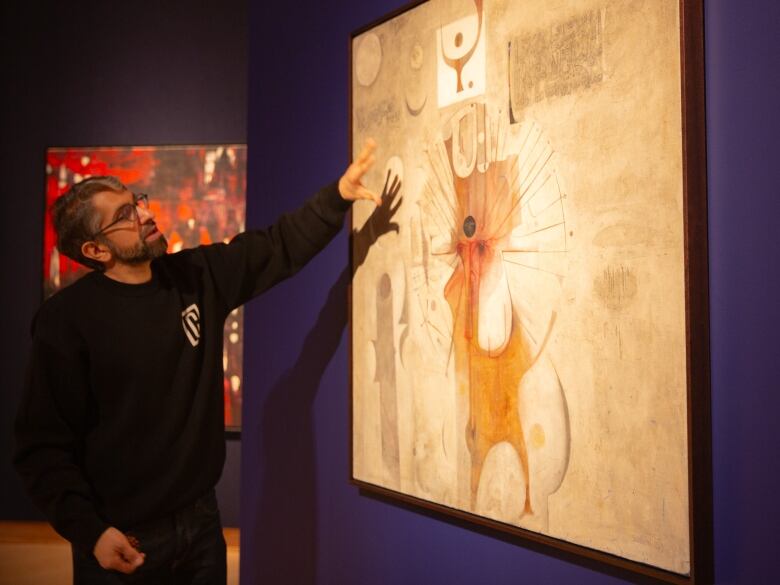London exhibition makes the case for raising the visibility of Arab women artists | CBC News
Growing up between Jordan and Lebanon in the 1980s and ’90s, Dia Al Batal would often hear the repetitive “tick-tick-tick … tick-tick” of a hammer and chisel as her mother, Mona Saudi, worked for hours on her stone sculptures.
As an Arab female artist, the path for Saudi wasn’t easy. Al Batal said her mother was turned down by exhibitors in Europe and the United States multiple times.
The Jordanian sculptor died in 2022, but one of her abstract sculptures, called “Continuity,” was part of a recent exhibition at Christie’s auction house in London called Kawkaba (“constellation” in Arabic).
“This is how my mom always wanted for her work to be displayed, in collections where the public would be able to access them, and not kind of hidden and tucked away,” Al Batal said in an interview in London.

The representation of Arab women in art has been a challenge worldwide, something the Christie’s show tried to redress. Kawkaba featured more than 100 pieces — half of them by women from various religions and ethnicities across the Middle East and North Africa.
Lina Khatib, director of the SOAS Middle East Institute at the University of London, said the exhibition, which ended Aug. 23, is an important contribution to changing how the artistic history of the Arab world is imagined and understood.
“A gender-balanced approach is hugely important, because it proves that the Arab world has no shortage of talented women artists,” Khatib said. She said a key challenge women artists face in the region is adequate recognition.
“There are many internationally renowned Arab women artists, but also many others whose great work is not as known as it deserves to be.”
Hurdles for Arab women in art
Dia Al Batal said her mother faced many challenges as a woman starting her career in art. Mona Saudi’s father did not encourage her passion, and at the age of 17, she ran away from Amman, Jordan, and moved to Beirut to pursue art.
In 1963, Saudi had her first exhibition in Beirut, and collected enough money to take a ship to Paris to continue her studies in art the following year.

“She came from a generation who did everything by themselves,” Al Batal said. “She built her own name and supported herself … the opportunities that were created, she created them for herself.”
Despite challenges, Saudi ended up having solo and group exhibitions around the world, and her work has been showcased and held in collections in galleries across the U.S., Europe and the Middle East.
An artist herself, Al Batal says she was influenced by her mother’s use of calligraphy and the Arabic language in her work.
Bahia Shehab, an artist, historian and professor at the American University in Cairo, said Arab women artists often struggle with a lack of funding and infrastructure.
“If you take the challenges of any male artist, double those and you have the challenges of women artists in the region,” Shehab said.
Kawkaba came together thanks to the efforts of Ridha Moumni, the deputy chairman of Christie’s Middle East and North Africa, and two members of the Barjeel Art Foundation, an initiative from the United Arab Emirates that preserves and exhibits Arab art: curator Suheyla Takesh and its founder, Sultan Sooud Al-Qassemi.
Al-Qassemi, a collector, said the artwork in Kawkaba represents political and cultural issues in the Arab world in the 20th century, covering themes like gender dynamics and Pan-Arab nationalism.
Establishing a network
Al-Qassemi said that as he was collecting pieces for his foundation, he found it challenging even to get the names of female artists, to authenticate their work and to document and archive their history.
He said he relied on a wide network, including social media platforms, to connect with various scholars, collectors and writers.

That included Mohamed Ali Osseiran, an interior architect and collector who runs an Instagram page to showcase the work of his aunt Samia Osseiran, a Lebanese artist. (Samia has a serious medical condition, so Mohamed is the one responsible for showcasing and signing her work, with her permission.)
Samia Osseiran, who paints on canvas and also works on paper, often takes her inspiration from the sun. Her painting “Formative Radiation” was selected to be the main painting of Kawkaba.
Mohamed said his aunt came from a family that encouraged the arts. She studied the craft in Lebanon, then Florence, Italy, and earned a scholarship to continue her studies in Japan.
But he said her work got very little notice before Kawkaba. Since the start of the exhibition in mid-July, he said he’s been getting daily calls from people asking about Samia’s art.
Arab women artists over time
Not all of the women featured in the exhibition have experienced similar challenges.
Afaf Zurayk, 75, a Lebanese painter and writer who calls her art “poetic rendering,” said she never felt discouraged from pursuing an artistic career.
“Men have it as difficult as women. It’s just that they pretend it’s easier,” said Zurayk, who has two paintings in the exhibition, from a series called Human Form.

Al-Qassemi’s aim with the exhibition was to give people the opportunity to expand their knowledge of the Middle East and North Africa region when it comes to art.
As the exhibition in London came to an end this week, he posted an Instagram story saying a number of works from the collection will be loaned across the U.S., Europe and the Middle East.
Bahia Shehab said the exhibition was proof that Arab women artists have long existed. But they need ongoing support.
“The patriarchy is still present,” Shehab said. “We need more men supporting women and we need more women supporting women.”
For all the latest Entertainment News Click Here
For the latest news and updates, follow us on Google News.

